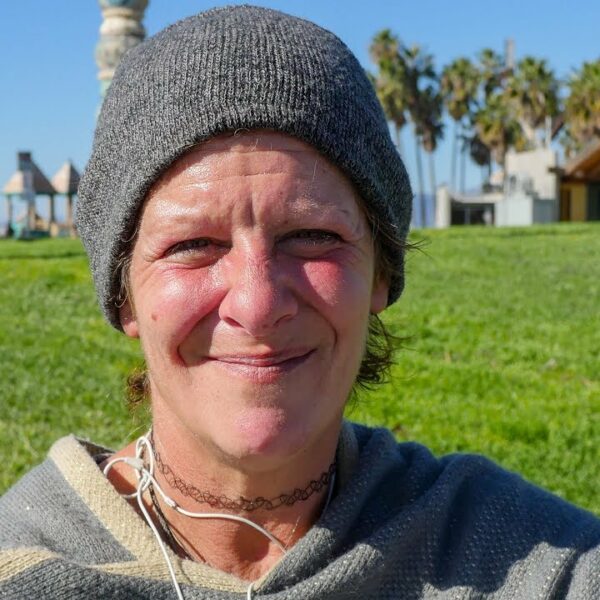Publication Highlights How IP Is Raising Awareness and Reaching Out to Help Those Experiencing Homelessness
For 12 years, Mark Hovath has been telling the stories of people experiencing homelessness through video. The goal has been to humanize these individuals, and motivate others to take collective action in ending this grand challenge. Over the years, Invisible People has been crucial in shifting cultural attitudes and beliefs surrounding our unhoused neighbors.
Most recently, one of Mark’s videos inspired a Los Angeles Times article. The author of this article documented her experiences traveling around Los Angeles. She asked individuals experiencing homeless about their specific needs, and provided those resources. She got this idea after seeing the video Mark produced of Koreatown residents coming together to help their own community.
Known as “KTown for All”, this group formed in response to mass community protests against a homeless shelter being built in the heart of Koreatown. One volunteer in the video, Steve, describes the group:
“We want to show that Koreans do care about homeless [people]; we do care about everyone in the community, and that’s why we’re here.”
One of the group leaders, Jane Lane, explained that volunteers engage in weekly outreach to encampments in their neighborhood. What makes their group special is they ask questions and listen to the individual needs of those they connect with. The group operates under the notion that homeless people are not a monolith. Just like their housed counterparts, each person is seeking something different. Some of the items the group has provided include eye drops, dog food, sandwiches, wipes, water. Furthermore, the group has a “Know Your Rights” flyer to pass out to these individuals.
According to Jane, “It’s the small things that help and really touch people.”
While conducting outreach, volunteers quickly found that most individuals they were helping were never approached by a professional outreach worker. This speaks to the scope of the homelessness problem in Los Angeles.
After watching the video, the author of the LA Times article realized the best way to help individuals experiencing homelessness is to directly interact with them and listen to their needs. With this knowledge in mind, she felt compelled to do this work in all parts of the city and report on it. Everywhere she went, she learned something new. On Van Nuys Blvd, a thinly-clothed woman expressed a need for a jacket or coat. She also showed disdain to folks who throw out their old clothes or donate them to thrift shops to sell.
Off the 101 freeway, a hungry woman explained how she often doesn’t trust home-cooked leftovers. In addition, she doesn’t have a refrigerator to store perishable food. Instead, what would be best for her is a gift card to a fast food restaurant.
Another person on Fairfax Blvd showed signs of decaying teeth. They also needed canned food such as chili and tuna.
Wherever the author went, she brought socks, as recommended by Mark. According to him, socks are essential for individuals to protect their feet from infections. The author saw just how grateful folks were for the socks. One individual responded very frankly when receiving the socks, “This is perfect.”
This author’s experience and story serving these individuals demonstrate that housed community members have an essential role in ending homelessness.
Homeless but not friendless: How a Facebook group supports people on the streets
A common myth some believe is that people experiencing homeless can’t afford and/or don’t have access to technology. In fact, this notion couldn’t be further from the truth. A recent study indicated that 94% of homeless adults in Los Angeles and Long Beach owned a cell phone, while 51% had phones with internet access. As founder of Invisible People, Mark saw this as an opportunity to connect these individuals with one another. With that in mind, he created a Facebook group for people currently or formerly experiencing homelessness, which was featured in the recent LA Times article “Homeless but not friendless: How a Facebook group supports people on the streets.”
This group acts as a safe space for homeless folks to share concerns, experiences, questions, or anything else they may have on their mind without any judgement or negativity from others. In addition to currently and formerly homeless individuals, the group includes allies and friends to this population, such as doctors, nurses, and social workers. Mark only requires a few simple guidelines for the group: treat others with kindness and generosity, everyone feels safe, no personal attacks or racism, and refrain from fundraising.
In a world where the general public often ignores individuals experiencing homelessness making them feel invisible, the group acts as a vehicle to let these folks know that they are not alone.
One woman interviewed in the article said, “You can go in there and get reinforcement without anyone trying to shrink you or fix you.”
This is especially important to those who have suffered traumatic events and/or experiencing mental health issues as a result. A study in the article indicated that 57% of homeless youth have suffered from a traumatic event. The group is used by folks with depression as a result from experiencing homeless to reach out to one another. According to one of the group’s moderators, the group prevented two suicides over the holidays. That admin explained, “You can reach out to the group and get a response within seconds.”
In addition to the emotional support, folks within the group connect others to resources, such as available shelters and medical services. Said one individual who posted a live stream to the group pleading for a shelter for her and her children:
“I don’t think I would be able to post that video on my regular Facebook. I don’t think people would understand me.”
This group is just the latest example of how technology can foster social change and connection among marginalized groups.













